While polymer piping systems have been specified and designed into commercial structures for domestic water and hydronic heating and cooling for many years now, there is still a misconception in the industry that these materials do not have the capability to withstand the rigors of commercial projects.
However, nothing could be further from the truth. Polymer piping systems are, in fact, more durable and sustainable compared to metals due to their corrosion resistance and ability to avoid scale buildup, providing a longer-lasting, higher-performing system.
Take PEX, for example. This polyethylene-based piping material has been successfully installed in projects throughout North America since the 1980s — and even longer in Europe. The product is flexible to eliminate unnecessary connections and improve system performance, while the decades-long projected lifespan provides building owners with tremendous peace of mind.

Available in sizes up to 3", PEX is the flexible, durable solution for risers, mains and in-unit piping systems.
While PEX originally hit the market as a radiant heating pipe available only in sizes up to 1 inch, its offering has expanded up to 3 inches to accommodate commercial domestic water, hydronic hot-water heating and chilled water applications. The product carries a hydrostatic temperature and pressure rating of 200° F (93.3° C) at 80 psi, 180° F (82.2° C) at 100 psi, and 73.4° F (23°C) at 160 psi. [Note that for domestic hot water (DHW) and DHW recirculation, operating conditions should not exceed 140° F (60° C) at 80 psi, which is in accordance with ASTM F2023.]
And the shape memory of PEX allows it to expand and shrink back down to its original size without compromising the integrity of the pipe, making it highly resistant to damage in freezing conditions. This benefit alone has proven to be a lifesaver in areas around the country — such as Texas — that experienced unexpected mid-winter freezes.
Another polymer piping solution that is gaining more traction in the commercial building sector is PP-RCT. Introduced as the next generation of polypropylene-based piping systems, PP-RCT is quickly gaining momentum in the commercial industry for domestic water and hydronic piping.
Most commonly available in sizes up to 12" (but can be up to 24" depending on manufacturer), PP-RCT is another piping solution that improves system longevity and performance with corrosion resistance and no scale buildup.
PP-RCT is significantly lighter in weight compared to metals (up to 80% lighter compared to steel) for less stress on a multi-story building and lower first costs. Plus, it has the potential to last decades longer than any metallic piping system on the market today.
Overcoming traditional challenges
Metallics historically have been the dominant material for commercial piping systems, and while they have their place in the industry, they sometimes have significant challenges that can be overcome by implementing polymer piping systems.
One of the biggest challenges with metals is their susceptibility to corrosion, rust and scale buildup, which lead to reduced system performance and premature failure of the piping system. A polymer piping system with PEX and/or PP-RCT has a service life of more than 50 years. That kind of longevity can oftentimes even outlast the building itself.
Another advantage of polymer piping systems is the joining systems do not use open flame, so engineers, installers, building owners and occupants can rest assured the piping system in their structure will not cause death or devastating damage from fire.
Additionally, polymer piping systems are not subject to pricing volatility with the market fluctuations. They are also easy to install. In most cases, PEX can install two, three or even four times faster, allowing projects to meet deadlines or even finish early.

PP-RCT is the newest generation of polypropylene-based pipe that offers higher temperature and pressure ratings compared to PP-R.
Also, polymer pipe has lower cost to the environment and lower cost of energy to produce the pipe. It also takes less energy to move the water through the pipe since there is no scale buildup to increase the pressure drop over time.
Finally, and probably the most significant benefit over the long term, is the fact that polymer piping systems come with a warranty. This gives everyone — from the engineer to the installer to the owner to the building occupants — complete confidence that the product is designed and manufactured to last.
Quick tips for polymer piping system design
Both PEX and PP-RCT are ideal for risers, mains and even underground piping applications. For in-unit applications, PEX is best due to its extreme flexibility in the smaller-diameter (1/2-inch and 3/4-inch) piping sizes.
While PEX is manufactured to copper tube size (CTS) for the outside diameter, the thicker walls result in a slightly smaller internal diameter compared to copper or other metallic systems. Hence, when designing and sizing a domestic water or hydronic piping system with PEX, it is important to use a PEX pipe-sizing calculator to get the proper design and sizing data.
When designing with PP-RCT, the first step is to select the pipe SDR (7.4, 9, 11, or 17.6). After gathering the temperature and pressure requirements for the application, simply select the SDR that meets those requirements.
It is important to note that PP-RCT can withstand higher pressures at a given temperature compared to PP-R pipe, and depending on the system, the increased temperature and pressure capabilities may allow the ability to downgauge the wall thickness of the pipes and still meet the performance requirements of the system. This can potentially save money in the budget while also saving space in the install area.
That said, before embarking on a polymer piping system design for the first time, it is beneficial to enlist guidance from experts in the field. Some manufacturers offer construction services to help maximize the design of these systems. These experts come with decades of experience in polymer piping system design and even have knowledge about certain PEX regulations in various jurisdictions across the country.
Learning all about the benefits and characteristics of these systems will help improve piping system and building design for the future and ensure greater sustainability and system performance for decades to come.



